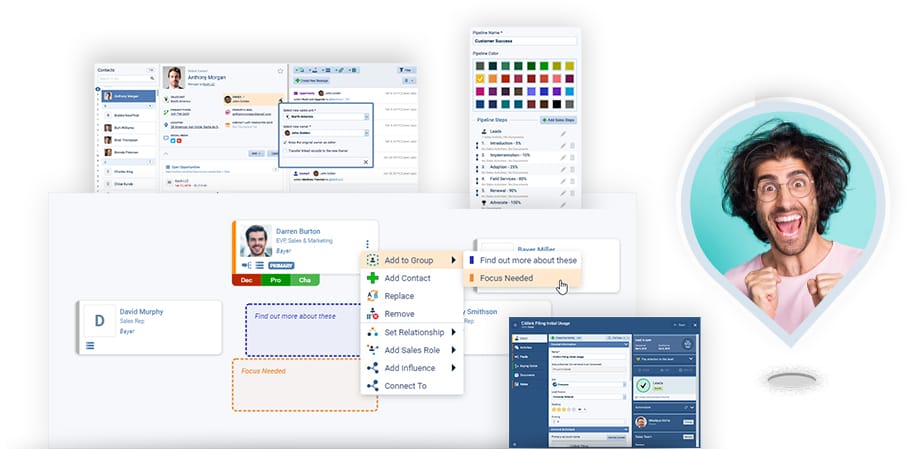What is CRM
- What is CRM?
- Customer Relationship Management Software
- Account Management Software
- Contact Management Software
- Sales Lead Management
- Opportunity Management
- Sales Pipeline Management
- Customer Relationship Mapping
- Sales Enablement Tools
- Sales Management Software
- Sales Process
- Sales Reporting
- Task Management
- Custom Fields
- Team Collaboration
- KPIs for Sales & Leading and Lagging Indicators
- CRM Past Failures?
Relationship Mapping
Because they frequently involve important stakeholders from both sides, B2BB2B B2B is an acronym for Business-to-Business, a model for selling, relationship-building, or engagement. relationships between two large firms can be highly complex. An overview of these commercial connections is provided by customerCustomer Customer is an individual or an organization that purchases a product or signs up for a service offered by a business. relationship mapping, which is very useful for customer successCustomer Success Customer Success is a proactive mindset, function, department or strategy commonly adopted by B2B companies to optimize business with customers, reduce churn rate, drive profits and increase the predictability of recurring revenue. and other departments like accountAccount Account refers to a record of primary and background information about an individual or corporate customer, including contact data, preferred services, and transactions with your company. management.
Among other advantages, it can assist you in finding ways to maximize retention, uncover ways to cultivate relationships with customers and identify cross-sell and upsell chances.
What is Customer Relationship Mapping?
An organizational chart showing the major decision-makers on both sides and their current relationship is included in relationship mapping, a visual representation of a customer’s account. This diagram, also known as a context diagram or interaction model, contains information about the motivations, objectives, and other considerations that may be important for the relationship between the two entities.
When creating a customer relationship map, there are several styles and approaches you can use, each offering its own perspective and level of detail:
Common Types of Customer Relationship Maps
- Tiles View Map
The simplest format, this map consists of tiles representing each stakeholderStakeholder Stakeholder is an entity with an interest in a company, process, or product, and which is typically concerned about its wellbeing., often color-coded to indicate the strength of each relationship. While it doesn’t show how stakeholders interact, it offers a quick snapshot of who’s involved and your current rapport. - Single Direction Map
Here, relationships are mapped in one direction or sequentially, showing the pathway to reach a key decision-maker—perhaps moving from a userUser User means a person who uses or consumes a product or a service, usually a digital device or an online service. to an influencer, then up to the executive. This approach is helpful when you need to visualize step-by-step engagementEngagement Engagement is the state or process of keeping a specific class of audience (employees, management, customers, etc.) interested about a company or brand and invested in its success because of its perceived relevance and benefits to the audience. strategies. - Multi-direction Map
This style acknowledges that relationships rarely flow in just one direction. It depicts the web of connections both within your organizationOrganization Organization is a cohesive group of people working together and formally bound by a shared identity (e.g., one team, company, club, etc.) and a common purpose (e.g., business growth, athletic victory, etc.). and the customer’s, across teams and departments, capturing the real-world complexity of account dynamics. - Organizational Relationship Map
Built on a classic business hierarchy, this map illustrates not only who the main stakeholders are, but also their roles and responsibilities—so you know precisely whom to approach regarding budgets, contracts, or technical issues. - Relationship Network Map
This comprehensive diagram displays all the existing links between your team and the customer’s stakeholders, often requiring a legend to decode the various connections. While it may seem complex, it provides a granular view of the entire relationship landscape.
Whether you build your map manually or with the help of software tools, the key is to use up-to-date information and ensure the map is accessible to everyone who needs it. The correct format for your business will depend on your resources, the complexity of your accounts, and the goals you’re aiming to achieve.
What is a Single Direction Map in Customer Relationship Mapping?
A single-direction map is a type of diagram within customer relationship mapping that illustrates how influence or communication flows one way—from one individual or group toward another. Picture it as a visual guide for understanding the chain of connections, typically when you’re aiming to reach a particular decision-maker within a clientClient A client is an entity who pays another entity for products purchased or services rendered. Also called a customer. organization.
For instance, if your end goal is to connect with an executive, the map might highlight an approach where you first engage with a frontline user, then an internal influencer, and finally reach the decision-maker. This step-by-step pathway helps pinpoint where to start building rapport and how to advance through the network strategically.
Single-direction maps are convenient when applying methods such as bootstrapping or pyramiding—concepts often used in sales and organizational strategy to gradually expand influence within a client’s structure.
What Is a Tiles View Map?
A Tiles View Map is one of the more straightforward ways to display a customer relationship map. In this format, each stakeholder appears as a separate tile—essentially, a visual “card” for every key contact. While this style doesn’t show direct links or the dynamics between people, it allows you to see who’s involved quickly. Often, you can use color coding within the tiles to easily highlight the status or strength of your relationship with each contact at a glance.
Customer Success Managers, Marketers, and Customer Support Representatives can all benefit significantly from Customer Relationship Mapping, which is an essential business tool for Account Managers. It can serve as a stepping stone for creating successful company plans that ultimately help achieve key business objectives.

What Are the Different Types of Customer Relationship Maps?
Just as businesses themselves come in all shapes and sizes, so too do the tools used to understand those intricate B2B connections. When it comes to customer relationship mapping, there are several visual formats that teams commonly use, each offering a unique perspective:
- Tiles View
This is the stripped-back approach: picture individual tiles, each one representing a key stakeholder. There aren’t any lines to connect them, but colors or icons can highlight the status or strength of the relationship with each person. It’s quick to scan and ideal for a high-level view. - Single Direction Map
If your goal is to understand the various steps required to reach a specific decision-maker, this method outlines a linear pathway. It tracks the flow of influence—think of it as following the breadcrumb trail, from user to influencer to buyerBuyer A buyer is an individual or organizational entity that purchases a product or subscribes to a service., revealing the exact chain you need to navigate. - Multi-Directional Map
Genuine business relationships are rarely linear, and this map reflects that. It connects stakeholders across teams and departments, illustrating the influence and communication that flow in multiple directions—both internally and between organizations. It’s beneficial for visualizing the tangled web of interactions in large accounts. - Organizational Relationship Map
Borrowed straight from the business playbook, this map resembles a classic org chart. It outlines the hierarchy and clarifies who is responsible for what—making it easier to identify the go-to people for approvals, budgets, or technical questions. Tools like LucidChart are often used to bring these charts to life. - Relationship Network Map
This version zooms out further, pinpointing every connection between your team and your client’s stakeholders through a sprawling web of lines. It’s less about hierarchy, more about mapping out every touchpoint, even if the result sometimes looks a bit like a plate of spaghetti. Legends or keys are usually essential to keep things organized.
By selecting the appropriate relationship map or combining several, you can gain much-needed clarity on key players, potential champions, and hidden blockers—putting your team in a stronger position to nurture and expand those crucial business relationships.
What is a Relationship Network Map?
A Relationship Network Map is essentially a visual snapshot of the web of connections between your organization and your customer’s key stakeholders. Imagine a board where each individual is represented by a compact tile, including only the essentials —such as name, role, and perhaps their influence or alignment.
The real magic happens in the lines drawn between these tiles, representing existing connections—whether it’s your account manager’s direct link to the customer’s procurementProcurement Procurement is the process of finding and acquiring goods and services, usually involving demand assessment, bid reviews, approval requests and transaction logging. leadLead Lead refers to a prospect or potential customer (who can be an individual or organization) that exhibits interest in your service or product; or any additional information about such entity. or your support rep’s partnership with their IT coordinator. As you map these relationships, the diagram can quickly become intricate, resembling the tangled routes of a London Tube map at rush hour.
To help navigate all those crisscrossed lines, a legend or key is typically provided, outlining how to interpret the different types of connections—be it direct contact, influence, or decision-making authority. This clarity enables your team to identify the most strategic paths for communication, ensuring that no critical relationship or hidden influencer is overlooked as you move forward.
What is a Multi-direction Map in Customer Relationship Mapping?
A multi-directional map goes beyond the simplicity of a basic organizational chart. Rather than illustrating just a top-down or linear connection, this approach highlights the web of interactions that exist not only between your company and your client, but also within each organization itself.
Think of it as a diagram that tracks the back-and-forth flow of influence and communication—across teams, between departments, and among individuals on both sides. For example, sales, operations, and support teams might all interface directly with different stakeholders at a client company, creating a network of relationships rather than a single chain. This helps customer-facing teams spot hidden influencers, potential blockers, and new champions, ensuring a more nuanced understanding of the business landscape.
Why Is It Important?
RevenueRevenue Revenue is the amount of money a business generates during a specific period such as a year or a quarter; also called sales. Generation
By selling more to your existing clients, you can increase your revenue by identifying cross-sell opportunities through customer relationship mapping. Key account managers specifically examine the map to find needs within the customer’s organization.
Getting New Customers
To direct prospects through the sales funnelSales Funnel Sales Funnel is a visualization of the sales process that defines the stages through which prospective customers go through as they are led by sales professionals towards a purchasing decision., you can identify crucial decision-making points and highlight their needs by analyzing the visual representation of the relationship you want to develop with them. Customer mapping will show you the order you need to take. This is especially useful when sealing the deal requires many touchpoints with people within that business.
Protecting Current Clients
Knowing where your consumers are having problems can help you address them before they decide to stop using your goods or services. Relationship mapping will also help you develop strong bonds with your clients. It can even help you identify potential competitors.
Easily integrating newcomers
You will occasionally welcome new team members, whether it’s because you choose to expand your key account management team or someone else is departing and you need to fill the role.
Customer relationship mapping can help new hires understand their responsibilities in-depth and visualize their place within the organizational structure.

Steps to Create a Relationship Map
A relationship map can be made simply and logically. You will almost certainly have a solid relationship map if you take the below steps.
1 › Clarify Your Interest
It’s crucial to clearly express your interests prior to starting the process of constructing your connection map.
There are three broad categories into which interests can be divided:
Short-term Objectives
Mid-term Objectives
Long-term Objectives
No matter how varied or streamlined your interests are, you must know how to prioritize them before you can begin to pursue them. The next stage is to prioritize and detect conflicts between these interests.
2 › Determine Every Relevant Stakeholder
Making sure that no one who matters is overlooked is the largest challenge in this step. Make a list of all the people who can influence negotiations in your customer’s company. Include the most significant individuals, such as the CEO, CFO, and COO. But also be sure to list any representatives who participate in negotiations or gain from your productProduct Product refers to anything (an idea, item, service, process or information) that meets a need or a desire and is offered to a market, usually but not always at a price..
3 › Determine the connections between the stakeholders
Once you comprehensively understand all parties involved, both on your end and those of your clients, you should analyze and ascertain all existing links between entities. There are three different categories of relationships that you should be aware of:
Deference
Due to a person’s position in the hierarchy, their level of seniority, or their level of knowledge, they will always comply with another person’s requests.
Influence
When someone is highly inclined to comply with another’s requested due to another’s credibility and trust.
Antagonism
When two people are at odds with one another, neither will do as the other requests. The first person can even demand that the second person do the exact opposite of what the first person wants.
4 › Create a Plan to Use With the Map
When the customer relationship mapping is complete, the moment has come to select a strategy and lay out a plan of action. Three well-known tactics are available for you to choose from:
- Bootstrapping: With this method, you must begin small, with less significant individuals and relationships. Then work your way up to more challenging partnerships.
- Pyramiding: This approach suggests starting with the most significant connections and working your way down to the ones that are simpler to exploit, which is the exact reverse of bootstrapping.
- Backward mapping: Discover the decision-maker who could make or break the deal first. Then work your way down the chain of command until you find the person who will be the easiest to influence.
Experience Pipeliner CRM Now
Relationship Mapping in CRM
Relationship mapping should ideally be integrated into your CRM solutionSolution Solution is a combination of ideas, strategies, processes, technologies and services that effectively helps an organization achieve its goals or hurdle its challenges.. Thus, a salesperson will constantly be aware of the position of the intended recipient in relation to all other influencers. This will happen both inside and outside of a company, before making a call, visiting, or even sending an email.
Maintaining a Healthy Relationship
The information in this article should help you create a relationship map that your key account management team can use. Use to enhance retention, increase income from current clients, and attract new clients. Relationship mapping is a complex process that might need further investigating.



